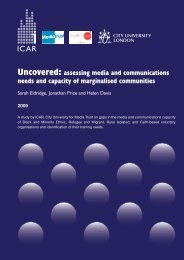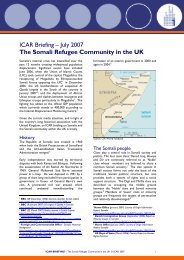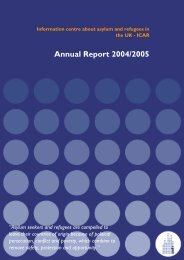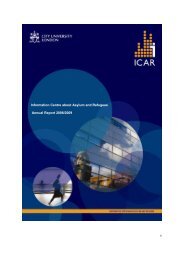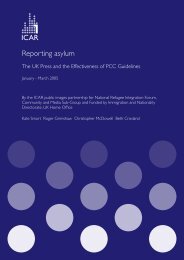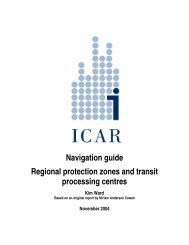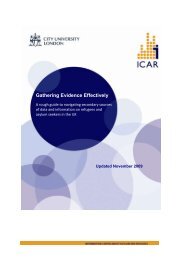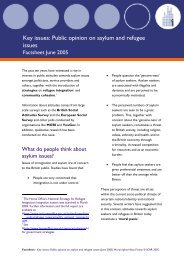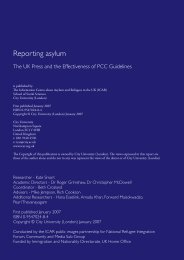Surveying Migrant Populations - ICAR
Surveying Migrant Populations - ICAR
Surveying Migrant Populations - ICAR
- No tags were found...
You also want an ePaper? Increase the reach of your titles
YUMPU automatically turns print PDFs into web optimized ePapers that Google loves.
Superdiversity(Vertovec 2007)• phenomenon that poses new challenges forresearchers• changes in immigration to the UK over last 20 years• increased levels• immigrants from all over the world• e.g. London:• plethora of immigration status• over 180 nations/14 faiths/300+ languages• 42 immigrant communities with 10,000+ people• wide range of rights/entitlements/restrictions(able to work, able to access public services)
Why do questionnaire surveys?Quantitative technique to obtain primary data on:‣ characteristics‣ behaviour‣ attitudes‣ awareness of specific issues‣ pros:• provides consistent/uniform data about a group of people• may allow for inferences about the wider population‣ cons:• expensive• time-consuming• tiring
Selecting the migrantpopulation: the sampleWhich migrant groups?• Any (e.g. if studying the low-paid)• Specific (Ghanaians, Brazilians, Poles)
Selecting the migrant population:the sampleCriteria: dictated by topic of study/target group• Age• Gender• Nationality• First language• Length of time in the country (years/months/weeks)• Immigration Status• Working or not• Marital status• With children or not
Selecting the migrant population:the sampleRepresentative sample?• Unlikely (at best ‘indicative’)• conditioned by‣ Knowledge of total size of group‣ Ability to achieve ‘representative’ sample‣ Official data often inaccurate (temporary/undocumented)e.g. Brazilian population in London‣ Census 2001: 8 000‣ estimated size in 2001: 50 000‣ estimated size in 2010: 200 00
What type of survey?How effective?Completion by researcher or their agents• face-to-face: most effective/most degree of control(e.g. can clarify issues/ more complete answers)• telephone (effective; some control)Completion by Respondent (self-completion)• postal (less control; poor returns, around 15%)• internet (less control, reasonable return 20%-30%)• e-mail (some control, reasonable return 30%+)Possible to combine different types
Designing the survey instrument(questionnaire)Questionnaire: content /format conditioned by• research theme: relevant questions• survey type‣ completion by researcher: less instructions‣ completion by researcher’s agents: detailed instructions‣ self-completion by respondent:: detailed instructionsWhat language?• respondent’s first language: greater interest/ highcompletion rate• English: obviously feasible but limitations/may needinterpreter
Designing the survey instrument(questionnaire)Important features:• Length: variable (long questionnaires: ‘fatigue’ bias)• Questions:‣ relevance: question must be really needed!‣ meaningful: ‘answerable’ by respondent‣ clear language: no jargon; definition of key terms‣ closed:‘do you like living in the UK? ‘yes’, ‘no’, ‘don’t know’‣ open-ended:‘what do you think of life in the UK?(these can be subsequently categorised)‣ numbers: best ‘raw’:age; year of birth; wages; number of years in UK
Designing the survey instrument(questionnaire)Demographics: key questions to include‣ Age‣ Gender‣ Country of Origin and Nationality‣ Ethnicity‣ Education‣ Length of time in the country‣ Immigration Status (very sensitive question)
Designing the survey instrument(questionnaire)Type of questions to avoid:‣ double-barrelled:‘do you feel affinity with Brazilians and the Portuguese inLondon?’‣ Negative/double negative• ‘would you rather not be undocumented?’‣ Habitual behaviour‘do usually you keep in touch with family in your homecountry?’‣ Leading/loaded questions‘don’t you think undocumented migrants in the UK deservean amnesty?’
Piloting the QuestionnaireEssential practice: reveals‣ unclear/ambiguous questions‣ sequence of questions(more sensitive in the middle or towards the end?)‣ whether instructions are clear(when to jump a question and where to go)‣ irrelevant questions‣ need for additional questions‣ better for better sequencing of questions
Accessing <strong>Migrant</strong> <strong>Populations</strong>How to get to your ‘sample’‣ gatekeepers: leaders of• community organisations• faith organisations• trade unions• migrant organisations‣ personal networks‣ snowballing‣ adverts in media in target group language(newspapers, magazines, radio stations)
Approaching the migrantpopulationInitial contact to explain survey• purpose• requirements‣ who is conducting research‣ why‣ who is to participate‣ where‣ when‣ how‣ how long for‣ how will data/results be disseminated and to whom?
Approaching the migrantpopulationInitial contact to explain survey• explain requirementse.g. need to sign forms (ethics form/receipts)• obtain ‘informed consent’• ensure anonymity(survey data never to be traced back to participant)• offer an incentive/reward (cash/product/service)
Approaching the migrantpopulationFollowing initial contact‣ date/time/venue for completing questionnaire is agreed‣ agreement is kept/questionnaire completed: hooray!Often‣ ‘patience’ and ‘determination’ required• need contacting several times• need re-scheduling several timesSometimes• after several contacts: interview unlikely to materialise
Conducting the Surveyface-to-face interviews:• where to conduct it? issues about safety(respondent/interviewer)• on public space‣ coffee shop‣ on the street• private space‣ respondent’s home‣ workplace (respondent/interviewer)When?‣ working hours‣ after work‣ weekends‣ special eventsParamount: both parties feel safe during survey (where/when)
Conducting the SurveyNeed to strike balance between• ensuring respondent is comfortable/relaxed• obtaining as full as response as possible• respondents feeling ‘uncomfortable’ leads to• loss of interest and vagueness• may not give ‘true’ answer• may abandon meeting altogetherNeed to keep to agreement(20 minutes must not become 1 hour)Ultimate aim:‣ to obtain ‘genuine’ answers (data of good quality)
Conducting the SurveyBefore conducting the survey, interviewer need to bethoroughly briefed about:‣ the questionnaire‣ how to conduct the interviewWhilst conducting the interview, interviewer needs‣ to create empathy and engage with respondent‣ to follow questionnaire as it is(ask all questions in the order they appear)‣ to follow instructions(‘read out options’; ‘don’t read out options’)‣ to abort activity if necessary(i.e. when circumstances change)
Processing the survey data• use software (e.g. SPSS)• enter the data• clean the data• code open ended questions• do the analysis‣ simple frequencies‣ cross-tabsProportion of employees foreign born by occupation• use tables and graphs London 1993/4 to 2004/580Validunderground (cleaning)hotel & hospitalityconstructioncare workcleaning and otherservicesfood processingTotalEmployment SectorCumulativeFrequency Percent Valid Percent Percent85 19.8 19.8 19.875 17.5 17.5 37.323 5.4 5.4 42.755 12.8 12.8 55.5175 40.8 40.8 96.316 3.7 3.7 100.0429 100.0 100.0706050(%) 403020100chefs, cooks catering assistants care assistants cleaners93/94 99/00 01/02 04/05
Disseminating the resultsEnsure that all interested parties have access toresults‣ respondents‣ organisations that helped accessing populationProvide access to:‣ hard copy‣ electronic version‣ version in first language of participantAsk for ‘feedback’ on report‣ may be useful for designing future research
ConclusionSurveys:‣ useful but time-consuming<strong>Surveying</strong> <strong>Migrant</strong> <strong>Populations</strong>:‣ sample composition (target group)‣ size (sample unlikely to be representative)‣ questionnaire needs to be fit-for-purpose‣ piloting essential‣ range of strategies to access target population‣ need to obtain informed consent and ensure anonymity‣ conduct interview in safe environment/relaxed atmosphere‣ make results accessible to all interested parties‣ learn from ‘feedback’





